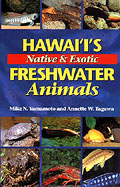By Jan TenBruggencate
Advertiser Science Writer
 |
| Hawai‘i’s Native and Exotic Freshwater Animals," by Mike N.Yamamoto and Annette W. Tagawa, 200 pages, softcover, Mutual Publishing $12.95. |
Most folks think about the sea when they consider aquatic life in Hawai‘i, but the Islands also harbor a wide array of freshwater creatures.
At first, you might only think of a few. There are ‘o‘opu, and crayfish, of course. Oh, and catfish at the reservoirs. Um, snails?
In fact, there is a huge diversity of life in the streams, lakes, ditches, reservoirs, and even underground caverns of the Islands.
To find out what they are, just check out the new book by state aquatic biologists Mike Yamamoto and Annette Tagawa, "Hawai‘i’s Native and Exotic Freshwater Animals."
You find out that you had no idea how diverse the collection is. And no idea that introduced creatures now outnumber native freshwater life by more than three-to-one.
"Although our native freshwater stream animals are small in number, they are unique," the authors write.
Most of Hawai‘i’s streamlife evolved from creatures that came in from the sea. Some, like the native gobies or ‘o‘opu, still spend parts of their lives in the ocean.
Other natives include shrimps, shellfish like the hihiwai, and even a freshwater sponge. Young mullets or ‘ama‘ama and flagtails or ‘aholehole come up in to the lower reaches of freshwater streams.
But the odds are that if you wander down to the edge of a stream in most areas, the things you see will be introduced, not native.
The alien stream species are much more diverse than the once that arrived on their own and evolved here. They have arrived as conscious imports - like Chinese softshell turtles, Samoan crabs, Tahitian prawns, rainbow trout and bass.
It wasn’t until the 1970s, the authors say, that state officials began viewing native streamlife as something worth preserving, and slowed the official influx of species.
But the new critters kept coming, some of them accidentally, such as in the bilgewater of ships from foreign ports, and some like aquarium fish, which people released into Hawaiian streams not realizing they were threatening the native species.
"Species such as the convict cichlid, midas cichlid, Johanni cichlid, jewel cichlid, suckermouth catfish, armored catfish, stickfish, apple snail and grass shrimp can all trace their origins to the aquarium fish and aquaculture industries," Yamamoto and Tagawa write.
They attack natives in different ways, sometimes disturbing habitat, sometimes feeding on young gobies and shrimps, and sometimes carrying diseases that can affect natives.
"Freshwater Animals" is a wonderful resource for people interested in the native and introduced freshwater aquatic life of the Islands, and a fine text for understanding some of the issues involved in management of these resources.
The photographs, most of them taken by the authors themselves, are crisp and readily allow identification of things you or the kids might find in the neighborhood stream.
[back to top] |

 The Great Index to Fun
The Great Index to Fun